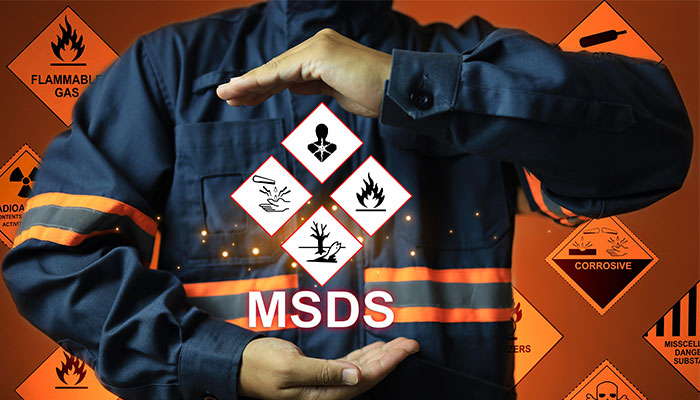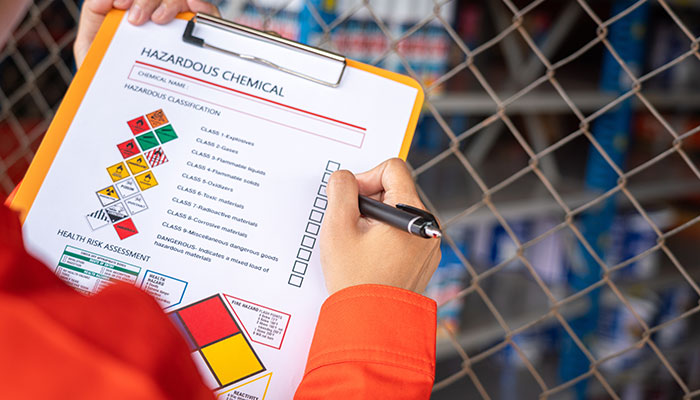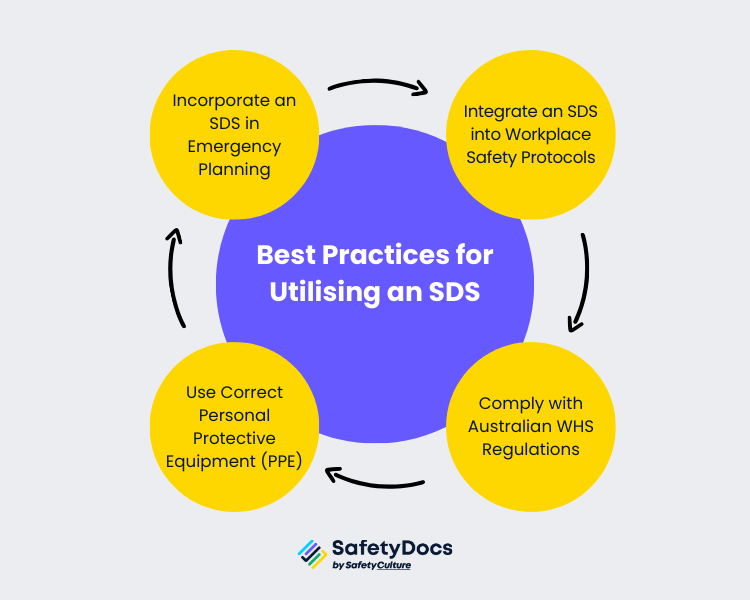Clear and readily accessible Safety Data Sheets (SDS) are essential for preventing potential hazards in the workplace. Picture a warehouse where employees regularly handle industrial solvents. By consulting the SDS before use, workers gain critical knowledge on proper storage, usage, and disposal, ensuring they can manage these substances safely and effectively.
But what would happen if there were no SDS? Workers wouldn't know about the potential hazards or how to mitigate risks when working with hazardous chemicals. Understanding Safety Data Sheets is key to workplace safety. This blog will explain what Safety Data Sheets are and how they help keep workplaces safe.
What are Safety Data Sheets (SDS)?
A Safety Data Sheet (SDS), formerly known as Material Safety Data Sheet (MSDS), is a standardised document that contains essential information about hazardous chemicals. They communicate the hazards, precautions, and safe handling instructions for each chemical in a workplace. They serve as a crucial resource to ensure that everyone in the workplace remains safe and informed. It is like a rulebook for handling potentially dangerous items responsibly.

When is a Safety Data Sheet (SDS) Used?
Safety Data Sheets (SDS) are indispensable in workplaces dealing with hazardous chemicals, and their use spans multiple scenarios. Here's when they are utilised:
- New Hazardous Chemical: An SDS offers essential info on handling, storing, and hazards of new chemicals at work.
- Safety Audits: Supervisors use an SDS to ensure hazardous substances comply with safety rules and regulations.
- Employee Training: An SDS helps employees learn about chemical risks and safe handling measures during training.
- Emergency Response: An SDS guides workers and responders on safe actions during chemical spills or exposure.
Why Safety Data Sheets Matter
Hazard Communication
Firstly, SDSs are the primary form of hazard communication, especially in workplaces dealing with chemicals like acids, solvents, pesticides, etc. They offer detailed information on each chemical's properties, including health effects, physical hazards, and environmental risks. Having a standardised way to communicate hazards helps keep everyone on the same page. An SDS ensures that workers consistently access critical data, regardless of the chemical's manufacturer or origin.
Compliance with WHS Regulations
In Australia, workplaces using hazardous chemicals must follow duties under the Work Health and Safety (WHS) Regulations. The primary responsibility is on the person conducting a business or undertaking (PCBU). PCBUs must identify and classify hazardous chemicals using the Globally Harmonized System (GHS). They must also maintain accurate labels and safety data sheets (SDS) for each chemical.
Understanding the Structure of an SDS
So, what makes up an SDS? SDSs have a standard 16-section format, with each section containing specific information about the physical and chemical properties of substance. The sections include:
- Identification: Includes chemical name, supplier info, and uses.
- Hazard(s) Identification: Lists handling hazards, GHS classification, and precautions.
- Composition/Ingredients: Details ingredients, concentrations, and hazardous impurities.
- First-Aid Measures: Immediate actions for accidents.
- Fire-Fighting Measures: Fire-fighting guidance and equipment.
- Accidental Release Section: Handling spills safely.
- Handling and Storage: Safe practices and storage advice.
- Exposure Controls/Protection: Exposure limits, PPE, and hazard controls.
- Physical/Chemical Properties: Physical attributes like appearance and melting point.
- Stability and Reactivity Section: Stability and reactivity hazards.
- Toxicological Information: Health effects, symptoms, and toxicity.
- Ecological Information: Environmental impact and disposal guidance.
- Disposal Considerations Section: Safe waste disposal methods.
- Transport Information: Handling and labelling for transport.
- Regulatory Information: Applicable regulations.
- Other Information: Preparation and revision dates.
How to Interpret SDS Information
Knowing the sections of an SDS is one thing, but understanding the information is another. Below is a guide on reading and understanding SDSs:
Hazard Informations
Hazard Symbols
In an SDS, a chemical's hazards are often represented using symbols or pictograms, which are graphical representations that indicate the hazard associated with a chemical. Each symbol corresponds to specific hazards defined by the GHS. For example:
Flame: Indicates flammability
Skull and Crossbones: Represents acute toxicity or fatal hazards
Exclamation Mark: Signifies less severe hazards such as irritants or skin sensitisers.

Precautionary Statements
Precautionary statements give instructions for safe handling and use of a hazardous chemical. These statements are standardised and follow specific formats. They are divided into three categories:
- Prevention: Measures to avoid exposure (e.g., "Wear protective gloves")
- Response: Actions to take in case of an incident (e.g., "If swallowed, do not induce vomiting")
- Storage: Recommendations for safe storage conditions (e.g., "Store in a cool, dry place")
Classifications
The hazard classification section outlines specific risks associated with the chemical, including:
- Signal Words: "Danger" indicates a more severe hazard than "Warning."
- Hazard Statements: These explain the hazards (e.g., "Causes skin irritation") and are coded (e.g., H315 for skin irritation) to show severity quickly.
First-Aid Measures and Emergency Response
Interpreting First-Aid Instructions
The first-aid measures section provides critical information on how to respond to exposure incidents based on the route of exposure:
- Inhalation: Move the affected person to fresh air and seek medical attention if symptoms persist.
- Skin Contact: Remove contaminated clothing and rinse skin with water for at least 15 minutes.
- Eye Contact: Rinse eyes cautiously with water for several minutes; remove contact lenses if present.
Handling Spills and Leaks
The SDS includes specific instructions for managing spills or leaks:
- Containment: Use absorbent materials to contain spills.
- Cleanup Procedures: Follow safe methods for cleaning up hazards, often needing PPE like gloves and masks.
- Disposal Information: Includes guidance on proper disposal of contaminated materials.
Best Practices for Using an SDS
Access to a Safety Data Sheet is only beneficial if workers know how to use and interpret them correctly. Some best practices for implementing SDSs include:
Integrate an SDS into Workplace Safety Protocols
Integrating SDSs into workplace safety protocols means making Safety Data Sheets a fundamental part of your organisation's safety practices. For instance, employees should have access to SDSs before handling any hazardous chemicals. How can you do it? This involves several key actions:
- Maintaining an SDS Register - A register is a comprehensive list of all hazardous chemicals used, stored, or produced in the workplace. It should include links to relevant SDSs.
- Training on Reading and Understanding SDS - Educate your employees on how to use and interpret SDSs.
- Regular Reviews - Ensure you regularly review and update the SDS register as new chemicals come into use or SDSs are revised.
Comply with Australian WHS Regulations
Another best practice for utilising SDSs is complying with WHS regulations. As mentioned above, SDSs are governed by these regulations, which align with the GHS of Classification and Labelling of Chemicals. Here are the key requirements regarding SDSs in Australia:
- Manufacturers and importers of hazardous chemicals must prepare an SDS before supplying them to workplaces.
- The SDS must be in English and include information relevant to Australian conditions.
- The SDS must include 16 sections covering various chemical aspects.
- Review the SDS every five years or when new information on the chemical becomes available.
- All SDSs must follow GHS 7 rules, which will feature updated hazard classes and safety instructions starting January 1, 2023.
- Suppliers can face legal issues if they don't provide a compliant SDS, including liability for injuries caused by poor hazard communication.
Use Correct Personal Protective Equipment (PPE)
An SDS will include specific safety precautions, for safely handling or using every hazardous chemical. These instructions may include using personal protective equipment (PPE), such as gloves, goggles, and respirators. For example, if a chemical is highly toxic when inhaled, the SDS will recommend wearing a respirator.
Incorporate an SDS in Emergency Planning
Incorporating SDS information into emergency response plans is critical. This involves understanding the hazards of chemicals in your workplace and having an evacuation plan in case of an incident. Additionally, emergency response plans should include instructions on accessing SDSs and communicating hazards to first responders if needed.

Complement Your SDS with Safety Documents
Safety Data Sheets should not be the only source of information on hazardous chemicals in your workplace. Employers may also provide other safety documents, such as Safe Work Method Statements (SWMS), risk assessments, and Standard Operating Procedures (SOPs), to complement SDS information.
You can utilise SafetyDocs by SafetyCulture, Australia's most trusted provider of safety documents to workplaces. We offer a comprehensive range of safety documents that can be personalised and specific to your needs. Check out these documents to start your safety journey today:
Contact us to learn how SafetyDocs can help your workplace stay safe, compliant, and productive.
Our team of experts is dedicated to providing accurate and informative content. Craig Cruickshank, our senior HSEQ advisor at SafetyDocs by SafetyCulture has reviewed this blog post to ensure the highest level of quality.
Learn more about Craig's work on LinkedIn for more industry insights.
Available for instant download and supplied in fully editable MS Word format for use in your business.
Please note that the above information is provided as a comment only and should not be relied on as professional, legal or financial advice.
Share This Article
